Horny Flip Flops: Why ERL’s Oiled-Up Erotica Is Working
By drenching the most ordinary product in erotic, absurd spectacle, ERL has shown that in 2025, desire isn’t about luxury, it’s about attention.
ERL’s Erotic Flip Flop Alchemy
On the surface, it’s a set of simple sandals. Basic black flip flops. A platform version so absurd it looks like a joke. These are not luxury objects. They’re the most mundane footwear imaginable. But wrapped in ERL’s new imagery, wet, oiled-up bodies, posed in overtly erotic tableaux, these flip flops have become the most talked-about thing on their feed.
And that’s the genius.

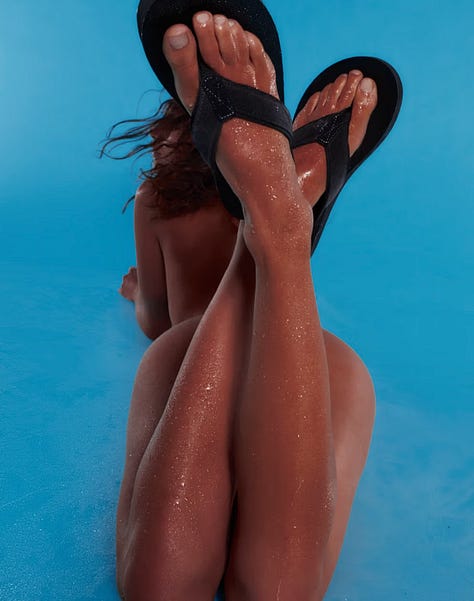
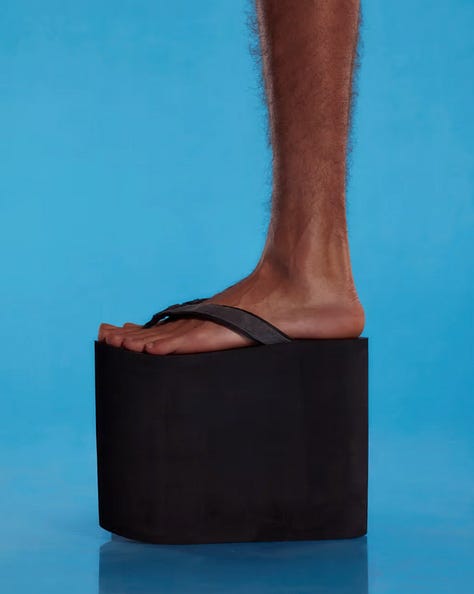
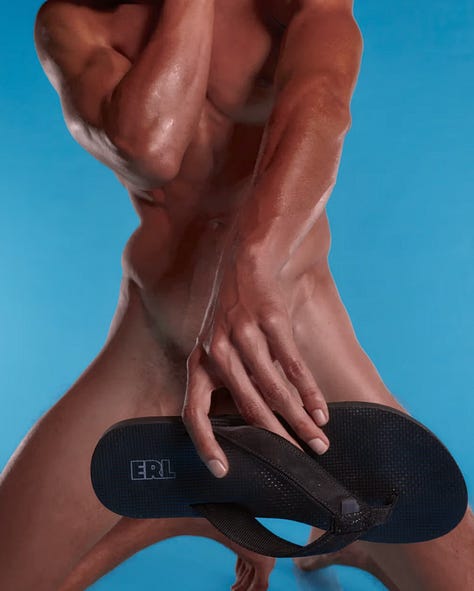
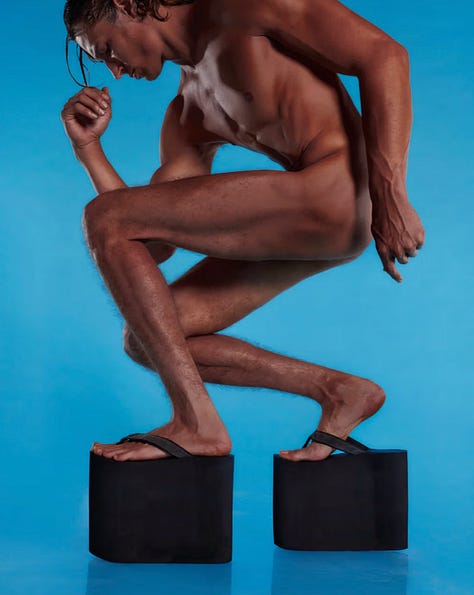
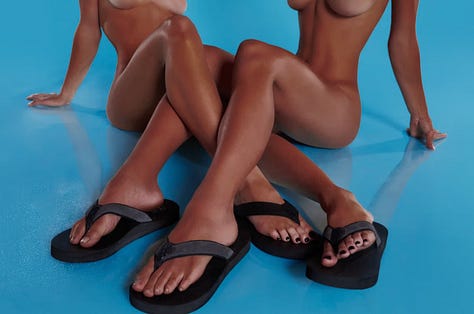
Sex as Spectacle
The campaign doesn’t flirt. It doesn’t tease. It doesn’t leave anything to the imagination. It goes straight for the erotic. Bodies slick with water and oil glisten under the light, tangled together in ways that feel closer to pornography than editorial. There’s no coyness here, no veil of artistry to soften the charge. The message is raw, direct, undeniable.
And that bluntness is exactly why it works. In a media environment where attention is the most valuable currency, subtlety often gets lost in the scroll. The internet rewards intensity, not nuance. The more blatant, the more shareable. In this landscape, coyness is weak, spectacle is strong.
This is not without precedent. Helmut Newton’s photography in the 1970s pushed eroticism into high fashion with a voyeuristic, cinematic edge. Calvin Klein in the 1990s built an empire on ads that blurred the line between sexual liberation and provocation, minimal denim worn like second skin, teenage bodies presented in ways that felt both pure and scandalous. Guy Bourdin, long before Instagram, turned advertising into surreal sexual theater, drenching shoes and bodies in fetishistic tableaux.
What ERL is doing now belongs to that tradition, but with an internet-age twist. Where Newton or Klein used provocation to shock print readers and spark cultural debate, ERL’s overt eroticism is engineered for virality. It isn’t about sparking controversy in magazines, it’s about creating images sticky enough to spread endlessly through feeds. The spectacle doesn’t live in galleries or on billboards, it lives in the infinite scroll.
And that’s the genius. It’s not really the sandal people are engaging with, it’s the spectacle of sex. Yet once the image circulates, the product becomes inseparable from the charge that carries it. The flip flop, once banal, now carries a voltage that exceeds its design. It has been alchemized into an object of attention, and attention is the new aspiration.
ERL isn’t simply selling footwear. He’s selling the electricity of desire, the spectacle of sex itself, and the product inherits that cultural voltage.
Elevating the Mundane
Flip flops don’t carry myths. They don’t radiate aura. They’re not aspirational, they’re disposable, the kind of object you buy at a gas station, wear until they break, and forget. In the hierarchy of fashion, they sit at the very bottom: functional, replaceable, invisible.
But ERL flips that logic by embedding them in eroticized spectacle. Suddenly, the most boring, unremarkable product becomes impossible to ignore. The sandal is no longer just footwear, it becomes a prop in a cultural performance. The body transfers its voltage to the object, and the disposable inherits desire.
This is the Duchamp trick repurposed for fashion. In 1917, Marcel Duchamp took a urinal, placed it in a gallery, and called it Fountain. He didn’t change the object, he changed its context. By reframing the banal as art, he forced the audience to see it differently, to reconsider its meaning. ERL does the same: he doesn’t redesign the flip flop into something avant-garde, he stages it inside an image charged with sex and absurdity. Context transforms contempt into fascination.
Fashion has played this game before. Martin Margiela elevated a blank white T-shirt into a cult object by recontextualizing it within his deconstructed world. Vetements turned DHL uniforms into high fashion by dragging the most utilitarian garment onto a Paris runway. What ERL achieves with flip flops belongs to that lineage, but his twist is eroticism. Instead of irony or critique, he drenches the mundane in desire, making the everyday feel dangerous, even forbidden.
And that’s why you can’t stop looking. The flip flop itself hasn’t changed, it’s still rubber and straps, but the frame around it has. Once staged inside an erotic fever dream, it acquires the charge of the image, and the disposable becomes unforgettable.
The Power of Absurdity
The oversized platform version takes the whole campaign further. It’s not just sexy, it’s ridiculous. The sheer impracticality of a platform flip flop turns the product into parody, a wink to the audience that says, we know this is absurd, but that’s the point. The result is a double-take: are we meant to laugh, be aroused, or feel unsettled? That uncertainty is what makes it unforgettable.
Absurdity functions as a cultural accelerant. It destabilizes expectations and opens up space for irony, humor, and debate. In an age where memes often have more impact than manifestos, absurdity isn’t a weakness, it’s a strategy. The ridiculous platform doesn’t undermine the campaign’s sex appeal, it amplifies it by layering in another emotional response: confusion. And confusion is sticky. It keeps the image circulating long after the scroll.
By colliding eroticism with absurdity, ERL ensures that the images won’t just titillate, they’ll live on as cultural references, screenshots, and punchlines. That’s how something as trivial as a sandal becomes a viral spectacle.
Desire + Virality
Your feed isn’t flooded with these images because the sandals themselves are remarkable. It’s flooded because ERL fused eroticism, absurdity, and banality into a single spectacle. That combination is the new alchemy of attention. Desire alone can seduce, but desire plus absurdity creates something more powerful: shareability.
The audience doesn’t just consume the imagery, they remix it, meme it, pass it along in group chats, joke about it on Twitter, or debate it in comment sections. And in that endless cycle of circulation, the product itself gains momentum. The sandal doesn’t need to justify its design, it inherits the energy of the cultural conversation that surrounds it.
This is why the flip flop is no longer just footwear. It’s a cultural artifact, charged with sex, humor, and controversy. It belongs less to the world of objects than to the world of images. ERL has turned a $100 piece of rubber into a lightning rod for attention, proving that in 2025, the product is secondary to the spectacle that frames it.
The Lesson
What ERL has demonstrated is that desire today isn’t anchored in aspiration, beauty, or even status in the traditional sense. Desire now lives in the clash of extremes, in the friction between the erotic and the absurd, the sacred and the banal. It’s not harmony that captivates, but collision.
By staging flip flops inside erotic fever dreams, ERL transformed one of the most mundane, disposable products into something magnetic, impossible to ignore. The sandal itself hasn’t changed, it’s still rubber and straps, but once charged with spectacle, it becomes a cultural artifact.
This is the new formula for resonance in 2025: sex fuels the image, absurdity fuels the meme, and together they fuel the product. The lesson is clear, in an era of infinite content, it’s not the object that matters most, it’s the voltage of the frame around it.



